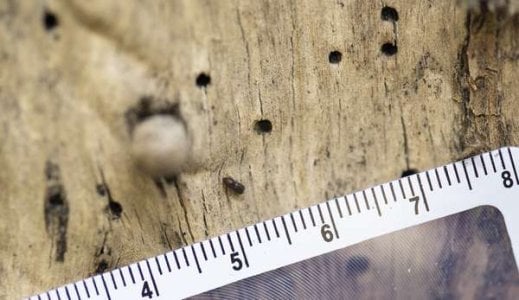Entire city is under quarantine over billion-dollar threat
By
Seia Ibanez
- Replies 29
Australia is renowned for its unique and diverse ecosystem, but this very distinction makes it particularly vulnerable to the threats posed by invasive species.
The latest menace to hit our shores is the polyphagous shot-hole borer, a tiny beetle with a voracious appetite and a penchant for destruction that has put the entire city of Perth under quarantine.
This invasive pest, originating from southeast Asia, has already wreaked havoc in several countries, including the United States, Israel, and South Africa, where it's estimated to have caused a staggering $28 billion in damage.
The polyphagous shot-hole borer is not just any garden-variety pest; it's a billion-dollar threat that has the potential to decimate native forests and agricultural crops across Australia.

The beetle has a symbiotic relationship with a fungus, and together, they can kill a tree within two years by disrupting the flow of water and sap to its roots and leaves.
The implications of such damage are profound, affecting not only the natural landscape but also the agricultural sector and the economy at large.
In response to the discovery of the beetle in Perth in 2021, authorities have taken drastic measures, including the felling of trees, some over a century old, in the Botanic Gardens.
Despite these efforts, experts remained sceptical about the possibility of eradicating the beetle. History has shown that the pest has only been successfully subdued once before in Europe, largely due to a change in weather conditions that made the environment less hospitable for the beetle.
The quarantine zone around Perth's metropolitan area has been expanded to protect the rest of Western Australia from the infestation.
The city has been divided into two zones, each with its own set of regulations.
Zone A, where beetle numbers are high, faces strict restrictions on the movement of plants, gardening equipment, and wood. Zone B serves as a buffer zone with similar restrictions but allows certain materials to be moved back into Zone A.
Vincent Lanoiselet, DPIRD Chief Plant Biosecurity Officer, has highlighted several tree species, including box elder maples, coral trees, Moreton Bay and Port Jackson figs, and London plane trees, as particularly susceptible to the borer.
‘Signs of borer activity include tiny holes the size of a ballpoint pen in the tree trunk or branches, staining or discolouration of the wood, gumming and frass, as well as signs of dieback in the tree,’ he said.
Biosecurity agencies have been warned that the country faces increasing threats from invasive insects as climate change alters weather patterns globally.
Tropical diseases like Dengue fever and several fungus species not yet established on the mainland are also expected to become problematic. Despite Australia's strong reputation for stringent quarantine protections, these defences are showing signs of strain.
The varroa mite infestation in NSW, threatening the country's honey production, and the relentless spread of fire ants from Queensland into northern NSW and the Murray Darling Basin are testaments to the growing challenges.

Have you noticed any unusual pest activity in your area? Share your observations and concerns in the comments below.
The latest menace to hit our shores is the polyphagous shot-hole borer, a tiny beetle with a voracious appetite and a penchant for destruction that has put the entire city of Perth under quarantine.
This invasive pest, originating from southeast Asia, has already wreaked havoc in several countries, including the United States, Israel, and South Africa, where it's estimated to have caused a staggering $28 billion in damage.
The polyphagous shot-hole borer is not just any garden-variety pest; it's a billion-dollar threat that has the potential to decimate native forests and agricultural crops across Australia.

The invasive polyphagous shot-hole borer has put Perth under quarantine. Credit: Department of Primary Industries and Botanic Gardens and Parks Authority
The beetle has a symbiotic relationship with a fungus, and together, they can kill a tree within two years by disrupting the flow of water and sap to its roots and leaves.
The implications of such damage are profound, affecting not only the natural landscape but also the agricultural sector and the economy at large.
In response to the discovery of the beetle in Perth in 2021, authorities have taken drastic measures, including the felling of trees, some over a century old, in the Botanic Gardens.
Despite these efforts, experts remained sceptical about the possibility of eradicating the beetle. History has shown that the pest has only been successfully subdued once before in Europe, largely due to a change in weather conditions that made the environment less hospitable for the beetle.
The quarantine zone around Perth's metropolitan area has been expanded to protect the rest of Western Australia from the infestation.
The city has been divided into two zones, each with its own set of regulations.
Zone A, where beetle numbers are high, faces strict restrictions on the movement of plants, gardening equipment, and wood. Zone B serves as a buffer zone with similar restrictions but allows certain materials to be moved back into Zone A.
Vincent Lanoiselet, DPIRD Chief Plant Biosecurity Officer, has highlighted several tree species, including box elder maples, coral trees, Moreton Bay and Port Jackson figs, and London plane trees, as particularly susceptible to the borer.
‘Signs of borer activity include tiny holes the size of a ballpoint pen in the tree trunk or branches, staining or discolouration of the wood, gumming and frass, as well as signs of dieback in the tree,’ he said.
Biosecurity agencies have been warned that the country faces increasing threats from invasive insects as climate change alters weather patterns globally.
Tropical diseases like Dengue fever and several fungus species not yet established on the mainland are also expected to become problematic. Despite Australia's strong reputation for stringent quarantine protections, these defences are showing signs of strain.
The varroa mite infestation in NSW, threatening the country's honey production, and the relentless spread of fire ants from Queensland into northern NSW and the Murray Darling Basin are testaments to the growing challenges.
Key Takeaways
- Perth's metropolitan area is now under quarantine due to the spread of polyphagous shot-hole borers, an invasive pest.
- The borers threaten to cause extensive damage, with an estimated $28 billion in damages in South Africa and the potential to destroy native forests and agricultural crops in Australia.
- The city has been divided into two zones with different restrictions to control the movement of plants, gardening equipment, and wood to prevent further spread.
- Authorities are struggling to protect Australia from invasive species, with the country facing increased threats due to climate change, including tropical diseases and pests.
Last edited:







